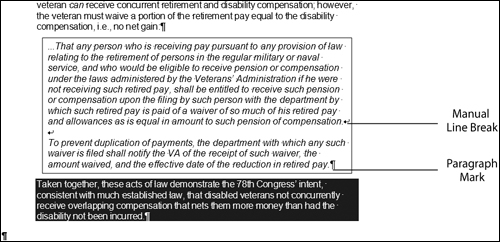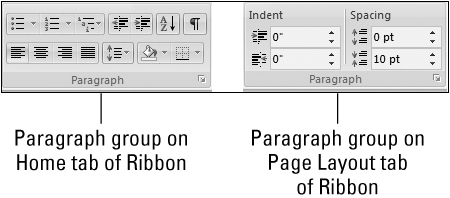What Exactly Is a Paragraph, Anyway?
With apologies to Mrs. Hewitt, my eighth-grade English teacher, a paragraph is everything between two different paragraph marks. Shown in Figure 6-1, the shaded block near the bottom is a complete paragraph. Note, however, that so is the solitary paragraph marker that follows the shaded paragraph. Moreover, the bordered block of italicized text above the shaded block is also a single paragraph, despite the fact that there is white space between the upper and lower portions.
Figure 6-1. A paragraph is everything between two paragraph marks. A paragraph mark without any text is called an empty paragraph.

Note that many new Word users often are distracted by the display of nonprinting characters (such as paragraph marks, manual line breaks, spaces, and tabs). As shown here, however, displaying them can give you essential clues about what’s going on in a document.
Sometimes it’s useful to break a paragraph horizontally, while still keeping it as a solitary paragraph. That way, any paragraph formatting you do to any part of the paragraph is done to the entire paragraph, despite its disjoint appearance. If the paragraphs are numbered or bulleted, it also prevents a new number or bullet from being assigned to what logically is a continuation, not a new item.
If you’re in the habit of working with nonprinting characters turned off, you might sometimes find that it’s useful to occasionally turn them on when trying to diagnose the behavior of text. They can be toggled by pressing Ctrl+Shift+8. If any marks don’t toggle, then check Word Options ![]() Display to see whether any are checked to be displayed all the time.
Display to see whether any are checked to be displayed all the time.
Another useful diagnostic aid in analyzing paragraph formatting is the Reveal Formatting pane, shown in Figure 6-2. You display it by pressing Shift+F1. It shows all of the formatting that’s common to the selected text, or that’s applied at the insertion point. It has three segments: Font (character formatting), Paragraph, and Section. (Thanks to Word’s thesaurus, I just neatly sidestepped having to refer to the bottom segment as the “section section.”) It also displays the selected text, if any, using the current common formatting, as best it can. If nothing is selected, then it displays the words “Sample Text” using common current formatting.
Figure 6-2. Press Shift+F1 to toggle the Reveal Formatting pane. It shows all of the formatting in effect for the selection.

Why do I say that it displays the common formatting? That’s because the selected text might not be formatted homogeneously. In this case, although you can’t see it, the sentence in the text was “It was a dark and stormy night.” Because bold and italic aren’t common to the entire selection, you can’t use Reveal Formatting to determine whether a given selection contains any formatting of a particular type.
Notice that the Reveal Formatting pane does not tell you what style is applied. We will look at other tools later on that help us with styles. In this chapter, we focus only on the paragraph segment.
Tip
The Reveal Formatting pane is not accessible from the Ribbon interface. If you want to be able to access it from the Quick Access Toolbar (QAT), you can add it. To do so, right-click the QAT and choose Customize Quick Access Toolbar. Choose Commands Not in the Ribbon from the Choose Commands From drop-down list. Click in the list and tap the S key to accelerate to the S’s, and then tap the up-arrow key seven times or so to select Reveal Formatting. Click Add ![]() OK, and you’re done.
OK, and you’re done.
Paragraph formatting attributes
Paragraph formatting, like character formatting, can be applied using a wide variety of tools that apply certain paragraph attributes. Many of those attribute controls, but not all, can be found on the Paragraph group in the Home tab of the Ribbon, shown in Figure 6-3. Indent and Spacing, both of which are paragraph attributes, are located on the Paragraph group in the Page Layout tab of the Ribbon, also shown in Figure 6-3. A number of attributes missing from the Ribbon are on the horizontal rulers: left and right indent, hanging and paragraph indent, and tab settings.
Figure 6-3. The Paragraph section in the Home tab of the Ribbon contains a number of paragraph formatting controls.

Many paragraph attributes, but again not all, are also found in the Paragraph dialog box, shown in Figure 6-4. You can display the Paragraph dialog box by clicking the Dialog Box Launcher in the lower-right corner of the Home tab’s Paragraph groups, by double-clicking any of the indent controls on the horizontal ruler, or by pressing the legacy keystrokes Alt+O, P.
Figure 6-4. The Paragraph dialog box contains controls for most, but not all, of Word’s paragraph attributes.

Missing from the dialog box, of course, are tab settings, which can be accessed by clicking Tabs in the Indents and Spacing tab of the dialog box. Also missing are borders and shading, which can be accessed by clicking Borders and Shading from the bottom of the menu that appears when you click the Border tool’s drop-down list arrow (in the Home tab), shown in Figure 6-5.
Figure 6-5. The Borders and Shading dialog box can be accessed from the bottom of the Borders control in the Home tab.

You might be wondering from all this how to determine whether a setting is a paragraph formatting attribute. One way is to see whether the attribute can be applied to a paragraph without selecting the whole paragraph. For example, if you click anywhere inside a paragraph and click the Center tool on the Home tab, the whole paragraph is centered. The same anywhere-in-the-paragraph rule is true for each of the other alignment options. The same applies to borders, shading, indentation, bullets, numbering, and line spacing.
Note, however, that two “paragraph formatting” attributes behave according to the if nothing is selected, format the whole paragraph rule, but behave differently if only part of a paragraph is selected. These two are shading and borders. While they generally are considered paragraph formatting, they also can be character formatting.
Paragraph formatting techniques
Two techniques can be used for all paragraph formatting attributes. As noted, you can simply place the insertion point in the paragraph you want and then choose the attribute (using the Ribbon, a dialog box, a keystroke, the context menu, or the Mini Toolbar).
The other technique is to select a range of paragraphs (up to and including the entire document). Note that even though shading and border formatting can apply to a selection of characters/words, if the selection includes or spans a paragraph mark, the formatting is applied to all of the full paragraphs in the selection, even those paragraphs that aren’t fully selected.
